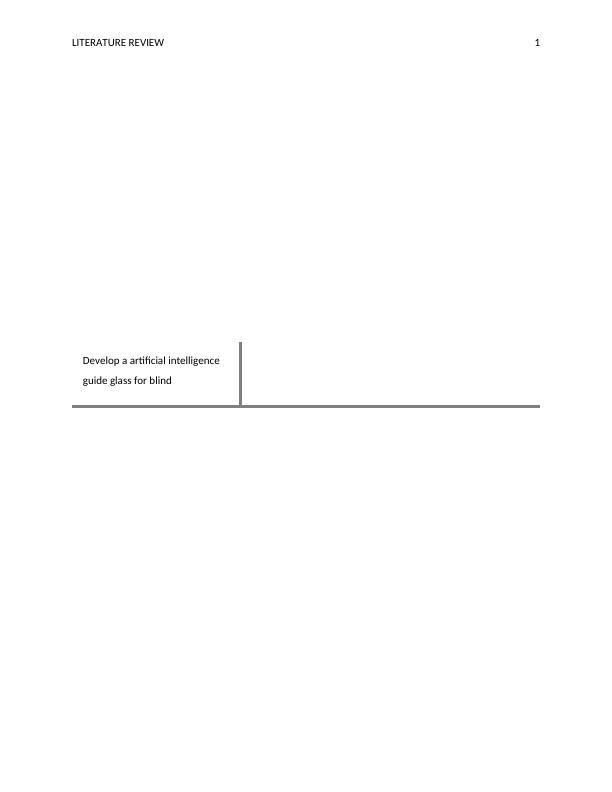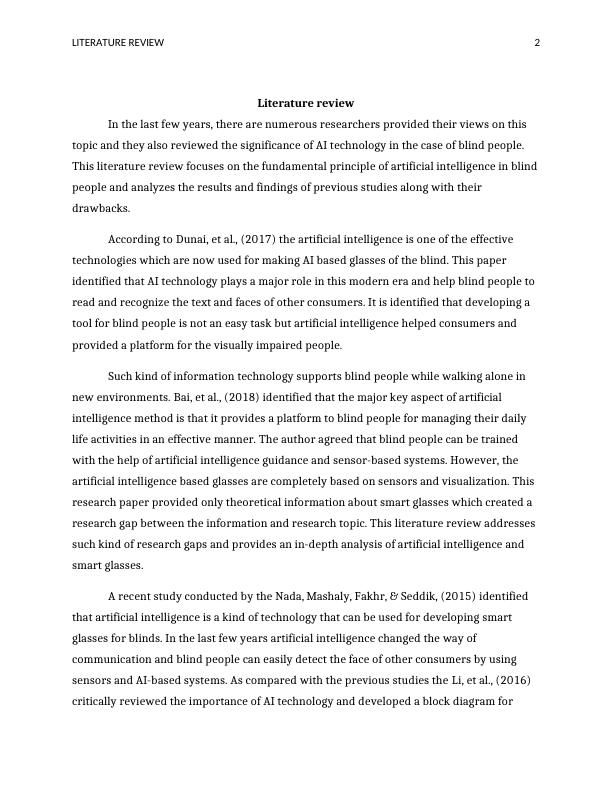Artificial Intelligence for Blind: Literature Review
Added on 2023-03-17
6 Pages1548 Words85 Views
LITERATURE REVIEW 1
Develop a artificial intelligence
guide glass for blind
Develop a artificial intelligence
guide glass for blind

LITERATURE REVIEW 2
Literature review
In the last few years, there are numerous researchers provided their views on this
topic and they also reviewed the significance of AI technology in the case of blind people.
This literature review focuses on the fundamental principle of artificial intelligence in blind
people and analyzes the results and findings of previous studies along with their
drawbacks.
According to Dunai, et al., (2017) the artificial intelligence is one of the effective
technologies which are now used for making AI based glasses of the blind. This paper
identified that AI technology plays a major role in this modern era and help blind people to
read and recognize the text and faces of other consumers. It is identified that developing a
tool for blind people is not an easy task but artificial intelligence helped consumers and
provided a platform for the visually impaired people.
Such kind of information technology supports blind people while walking alone in
new environments. Bai, et al., (2018) identified that the major key aspect of artificial
intelligence method is that it provides a platform to blind people for managing their daily
life activities in an effective manner. The author agreed that blind people can be trained
with the help of artificial intelligence guidance and sensor-based systems. However, the
artificial intelligence based glasses are completely based on sensors and visualization. This
research paper provided only theoretical information about smart glasses which created a
research gap between the information and research topic. This literature review addresses
such kind of research gaps and provides an in-depth analysis of artificial intelligence and
smart glasses.
A recent study conducted by the Nada, Mashaly, Fakhr, & Seddik, (2015) identified
that artificial intelligence is a kind of technology that can be used for developing smart
glasses for blinds. In the last few years artificial intelligence changed the way of
communication and blind people can easily detect the face of other consumers by using
sensors and AI-based systems. As compared with the previous studies the Li, et al., (2016)
critically reviewed the importance of AI technology and developed a block diagram for
Literature review
In the last few years, there are numerous researchers provided their views on this
topic and they also reviewed the significance of AI technology in the case of blind people.
This literature review focuses on the fundamental principle of artificial intelligence in blind
people and analyzes the results and findings of previous studies along with their
drawbacks.
According to Dunai, et al., (2017) the artificial intelligence is one of the effective
technologies which are now used for making AI based glasses of the blind. This paper
identified that AI technology plays a major role in this modern era and help blind people to
read and recognize the text and faces of other consumers. It is identified that developing a
tool for blind people is not an easy task but artificial intelligence helped consumers and
provided a platform for the visually impaired people.
Such kind of information technology supports blind people while walking alone in
new environments. Bai, et al., (2018) identified that the major key aspect of artificial
intelligence method is that it provides a platform to blind people for managing their daily
life activities in an effective manner. The author agreed that blind people can be trained
with the help of artificial intelligence guidance and sensor-based systems. However, the
artificial intelligence based glasses are completely based on sensors and visualization. This
research paper provided only theoretical information about smart glasses which created a
research gap between the information and research topic. This literature review addresses
such kind of research gaps and provides an in-depth analysis of artificial intelligence and
smart glasses.
A recent study conducted by the Nada, Mashaly, Fakhr, & Seddik, (2015) identified
that artificial intelligence is a kind of technology that can be used for developing smart
glasses for blinds. In the last few years artificial intelligence changed the way of
communication and blind people can easily detect the face of other consumers by using
sensors and AI-based systems. As compared with the previous studies the Li, et al., (2016)
critically reviewed the importance of AI technology and developed a block diagram for

LITERATURE REVIEW 3
better understanding about smart glasses. This paper reduced the gaps and drawbacks of
previous journal papers and identified that AI technology requires more efforts and
approaches while configuring the glasses for blinds.
However, the authors also conducted a survey and evaluated that most of the blind
individuals suggested that AI-based guidance and smart glasses helped them for reading
the text and other points. Mainly, the AI based glasses uses a camera and connectivity
process in order to assist consumers with a visual impairment. With the help of artificial
intelligence guide, blind users can detect objects, reading documents and connect things
with the system that monitor the physical activities of blinds. This paper and a previous
study conducted by Morrison, et al., (2017) provided a similar conclusion about artificial
intelligence guidance on smart glasses. The author disagreed that artificial intelligence
require more efforts and configuration but it is true that such kind of technology can help
consumers who are suffering from the blindness. From this paper, it has found that there
are around 350,000 blind consumers in Australia and AI technology reduced their efforts
and provided a new way of completing their daily life activities.
Ahmad, Ang, Ng, & Wahab, (2015) suggested that the AI based application can be
developed and implemented for the vision impaired consumers. By using such kind of
guidance consumers can point their mobile at the pantry in order to determine the
vegemite and can help children for solving completing their homework. The author also
argued that AI-based glasses means consumers can hold their smartphone up to a
consumer and it can provide information about a person like their age, body language, their
hair and so on. By wearing such kind of smart glasses consumers who are facing the issue
of vision impaired can look happy and enjoy their daily life.
The major problem of this paper is that the researcher provided very less
information about AI technology which can produce a research gap in the research.
However, it is analyzed that the artificial intelligence guidance for blind people can read
documents and make sense of structural factors for example headings and list by which
consumers can effectively navigate the documents with the help of voiceover technique
(Simões, & De Lucena, 2016). Therefore, the researchers concluded that AI-based smart
better understanding about smart glasses. This paper reduced the gaps and drawbacks of
previous journal papers and identified that AI technology requires more efforts and
approaches while configuring the glasses for blinds.
However, the authors also conducted a survey and evaluated that most of the blind
individuals suggested that AI-based guidance and smart glasses helped them for reading
the text and other points. Mainly, the AI based glasses uses a camera and connectivity
process in order to assist consumers with a visual impairment. With the help of artificial
intelligence guide, blind users can detect objects, reading documents and connect things
with the system that monitor the physical activities of blinds. This paper and a previous
study conducted by Morrison, et al., (2017) provided a similar conclusion about artificial
intelligence guidance on smart glasses. The author disagreed that artificial intelligence
require more efforts and configuration but it is true that such kind of technology can help
consumers who are suffering from the blindness. From this paper, it has found that there
are around 350,000 blind consumers in Australia and AI technology reduced their efforts
and provided a new way of completing their daily life activities.
Ahmad, Ang, Ng, & Wahab, (2015) suggested that the AI based application can be
developed and implemented for the vision impaired consumers. By using such kind of
guidance consumers can point their mobile at the pantry in order to determine the
vegemite and can help children for solving completing their homework. The author also
argued that AI-based glasses means consumers can hold their smartphone up to a
consumer and it can provide information about a person like their age, body language, their
hair and so on. By wearing such kind of smart glasses consumers who are facing the issue
of vision impaired can look happy and enjoy their daily life.
The major problem of this paper is that the researcher provided very less
information about AI technology which can produce a research gap in the research.
However, it is analyzed that the artificial intelligence guidance for blind people can read
documents and make sense of structural factors for example headings and list by which
consumers can effectively navigate the documents with the help of voiceover technique
(Simões, & De Lucena, 2016). Therefore, the researchers concluded that AI-based smart

End of preview
Want to access all the pages? Upload your documents or become a member.
Related Documents
Artificial intelligence is a branch of computerlg...
|15
|3753
|13
Artificial Intelligence in Healthcare Sectorlg...
|22
|1364
|14
Research Paper Literature Review 2022lg...
|10
|2860
|22
Research Development in Information Technologylg...
|10
|2270
|469
Revolution by Artificial Intelligencelg...
|13
|2738
|295
Scope of AI in Education System 2022lg...
|8
|1448
|25
